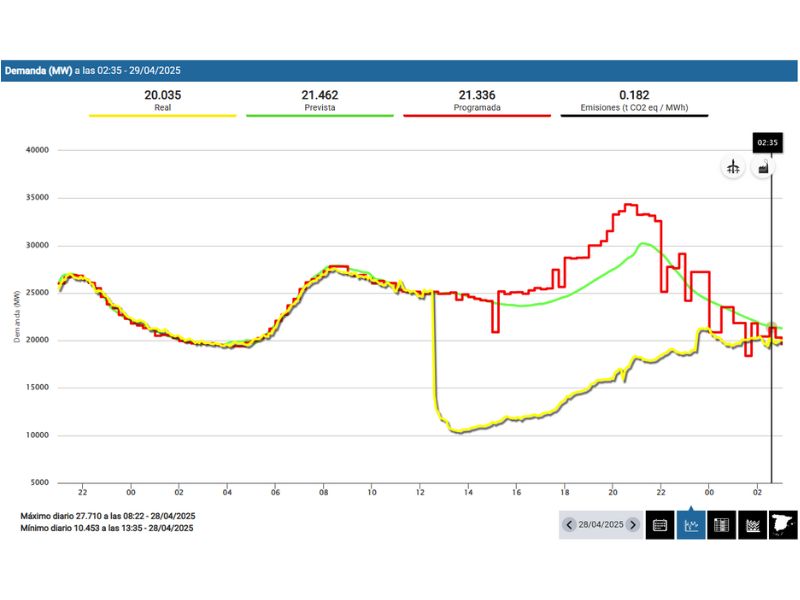Temporary power isn’t just about keeping the lights on. It’s about maintaining life support, data, logistics, communications and essential public services that society can’t function without.
Lessons from Spain’s 2025 Iberian Blackout: How UK Infrastructure Must Prepare
On Monday, 28th April 2025, Spain’s national electricity system collapsed, and it happened fast. The nationwide blackout took place after around 15 gigawatts (GW) of electricity-generating capacity, equivalent to 60% of Spain’s power demand at the time, dropped off the system within seconds. Trains stopped, communications dropped out, and critical services were thrown into chaos. Restoration took hours, with large parts of the country left without power and critical systems offline during that time.
The near-total power outage affected millions of people. Spain and Portugal experienced the most extensive blackouts, but Andorra and the Basque region of France also reported outages. The blackout was reported to be the biggest in Europe’s history.

Simon Gallagher from UK Network Services says: “The blackout in Spain looks like a similar event to what happened in the UK in 2019. In the UK, we had a couple of trips close together of generation, but in the UK, low-frequency disconnection stepped in and saved the day. In Spain, after the ‘third event’, it looks like a cascade failure, where they dropped 15GW within 5 seconds.”
This white paper looks at what went wrong in Spain, why it matters to UK organisations running essential services, and what you can do to prepare before the next major event hits our side of the grid.
The cause wasn’t malicious, but it reveals just how fragile modern energy systems have become.
What happened in Spain?
At 13:20 CEST, the Spanish grid saw an unprecedented drop in demand, from over 27GW to just 15GW in seconds. According to grid frequency data captured at the time, the system experienced a sudden destabilisation followed by cascading failures across multiple parts of the network.
The initial cause of the generation loss hasn’t been publicly confirmed, but early data shows a large generation trip followed by further cascading failures. System frequency dropped faster than protections could handle, forcing generators offline. With inertia already low, there was no time to stabilise. More protection systems kicked in, and the entire system began to collapse.

The incident moved so fast that some assets disconnected before grid operators could intervene. It’s a textbook example of how a small fault, in the wrong conditions, can trigger a widespread outage.
Further analysis confirms how quickly the collapse unfolded. Within 27 seconds of the first generator trips, Spain’s entire system had failed. Protection schemes such as Low Frequency Demand Disconnection were activated but had little effect, likely overwhelmed by the speed of frequency decline and a lack of rotating mass to slow it. While renewable energy wasn’t the direct cause, how these assets are integrated played a role. More grid-forming inverters and greater system inertia are needed to improve resilience. Spain’s engineers completed a full black start by 04:00 the next morning, a rapid recovery. In the UK, similar restoration is expected to take significantly longer.
Recovery efforts began immediately, but power was restored gradually, with essential services prioritised. Some critical systems remained offline for hours, underlining how far-reaching the impact of grid failure can be.
Could it happen here?
The UK grid isn’t identical but shares similar characteristics, leaving it exposed to the same risks. In fact, many of the factors that contributed to the Spanish failure also apply here. The UK runs with increasing levels of renewable energy, less spinning reserve, and greater reliance on interconnectors to manage demand. System frequency is more volatile than it used to be. Inertia is lower. Protections are tighter. And in certain conditions, those protections can make things worse by taking assets offline too quickly.
The 2019 UK blackout proved that risk exists. Two almost-simultaneous events caused major disruption across transport and healthcare networks six years ago. Since then, demand has grown, complexity has increased, and recovery margins have shrunk.
When events unfold fast, organisations need a plan.
Why temporary power matters
If your operation can’t tolerate a grid failure, then you need a backup plan. That’s where temporary power solutions come in. The right temporary power supplier offers fast, flexible, scalable support, delivered by experts who understand the risk and the infrastructure. Not all failures are planned. But the response can be.
How MEMS supports critical infrastructure
MEMS Power Generation works with hospitals, banks, utilities, telecom providers, data centres and transport operators across the UK to keep essential services running when the grid goes down. We’re Ready. Not weeks later. Now.
We provide:
- Temporary generator hire, available 24/7 for emergency or planned resilience
- 24/7 support from a manned control centre
- MEMS Connect: remote monitoring handled by our team
- Scalable distribution and configuration to suit complex infrastructure
- Reduced-emission fuel options to support sustainability targets
- On-call support from technical experts before, during, and after supply
We also support clients with expert planning ahead of deployment, so if the grid goes down, there’s no guesswork.
This isn’t about replacing existing systems. It’s about reducing the time between failure and full power restoration. Don’t wait until your site is in the dark to start planning. MEMS work with you in advance to identify what’s needed, where, and how fast.
It’s not theory, it’s action. And we’ve done it for decades.
What to ask now
If you’re responsible for critical services, ask yourself:
- What’s our recovery time if the grid fails entirely?
- What happens if recovery takes longer, or doesn’t come?
- Who do we call when we need power at speed?
You don’t need a national crisis to ask these questions. And you don’t need a complicated solution to answer them. But you do need a partner who understands what’s at stake.
This isn’t about panic. It’s about planning.
MEMS is ready. The question is…are you?
Spain didn’t expect to lose its grid in seconds. No one does. But those who operate essential infrastructure, such as healthcare, utilities, telecoms, and banking, don’t get to rely on hope. They need options, and those options need to work under pressure.
No system is invincible. Spain proved that. The UK grid is advanced and well-managed, but it’s operating in tighter conditions with more complexity and lower margins for error than ever before.
As the pressure on energy systems continues to grow, resilience isn’t a nice-to-have, it’s a core operational need. Temporary power isn’t just about keeping the lights on. It’s about maintaining life support, data, logistics, communications and essential public services that society can’t function without.


